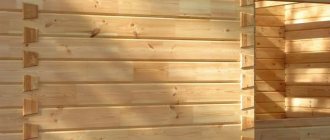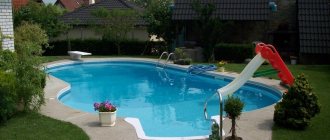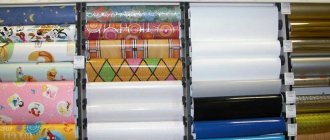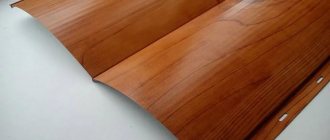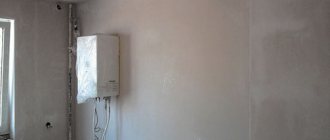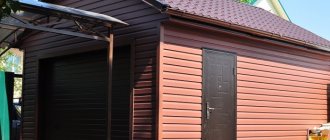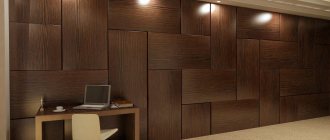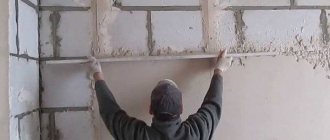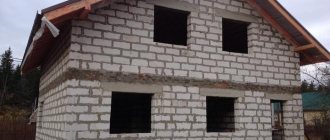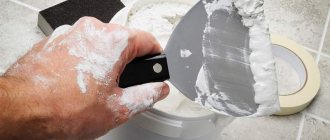Requirements for finishing material
A garage is a specific room. Firstly, in most cases the garage is not heated, so temperature changes will be significant. Secondly, there may be high humidity here. Thirdly, aggressive chemicals and flammable liquids are used in the garage. After all, there are a lot of sources of dirt in this room. The finishing material must withstand all these factors, therefore the following requirements are put forward to it:
- resistance to temperature changes, frost resistance . In an unheated room, a lot of fairly significant temperature jumps can be observed in just one season. Not every finishing material will be able to cope with such an impact while maintaining its integrity and all its performance qualities;
- fire resistance . Gasoline, diesel and many other substances used for car maintenance and care are very flammable. In order for the garage to be a safe place for both the car and its owner, it is necessary to choose materials that are as fire-resistant as possible;
- mechanical strength . Since impacts and collisions in the garage are not excluded, it is better to choose a cladding that can withstand such impacts;
- resistance to aggressive chemicals . Household chemicals that come into contact with some materials can destroy them. If you do not want the cladding to lose its aesthetics and important performance qualities after just a few months of operation, it is better to choose a material that can withstand contact with fuels and lubricants, acids, oils, lubricants and other substances;
- ease of care . A garage is a fairly dirty room, but it is necessary to keep it clean, and it will be easier to do this if you have a lining that is easy and quick to clean;
- price . Everyone’s budget is different, but in each price category there are more or less suitable materials;
- aesthetics . The appearance of the garage wall decoration, of course, matters, but not the key one. Aesthetically, the cladding is required to be neat.
Some car owners would also add ease of updating . Even the strongest and most durable material sooner or later ages, and when this moment comes, it will be better if the cladding is as simple as possible to refresh, or simply replace some of its elements.
Fortunately, there are plenty to choose from, and below we will look at the most suitable materials for interior decoration of garage walls.
Where to begin?
Most owners of country houses try to make them as comfortable, cozy and hospitable as possible. The atmosphere in the home should be calm and pleasant. The listed factors largely depend on the choice of suitable finishing materials. More recently, in houses, the walls were first plastered, then painted or wallpapered. Today, the market for construction and finishing materials offers many more products that can radically change the appearance of the environment, making it more harmonious and attractive.
When designing different foundations in a country house, a number of other features should be taken into account.
Seasonal factor. If you visit a country house only in the summer season or on weekends, then constant heating is most likely not provided. In this case, it is recommended to select materials for finishing that can withstand high levels of humidity or low temperatures.
Style factor. The finishing should be selected in accordance with the stylistic direction in which the rooms in the country house are designed. The color range of materials also depends on this factor.
Time factor. If you are a small fan of frequent repairs, it is better to immediately purchase high-quality finishing materials in calm, natural shades. If change is your thing, and you are ready to make repairs every few years, then you can turn to more affordable, budget products.
Preparation factor
This simple rule will protect homeowners from unexpected interruptions in work, as well as unnecessary cash costs.
Order factor. Finishing the inside of a country house can be called the final stage of work. You can begin such procedures after completing the installation of electrical wiring and communications related to plumbing.
No. 1. Plaster
This is one of the most budget-friendly, and therefore most popular, ways to decorate a garage space. This cladding method is almost ideal for the requirements described above. The list of advantages is significant:
- relatively low cost , and this is what you need for a garage;
- the ability to level and hide minor imperfections in the base, so preparatory work is greatly simplified;
- plaster does not take up useful space , unlike finishing that must be mounted on the frame, for example, drywall;
- wear resistance , strength, relative resistance to mechanical damage;
- fire and mildew resistant;
- resistance to temperature changes , moisture resistance;
- durability;
- application speed;
- simple but cute appearance .
No matter how much you would like to, it is still impossible to call plaster an ideal coating for finishing garage walls, and the following disadvantages :
- complexity of application and “dirty” installation process. You should only undertake finishing work yourself if you are 110% confident in your own preparation. Otherwise, it is better to entrust the work to specialists. If mistakes are made during installation of the plaster, then in the first winter, due to temperature changes, cracks will appear on the surface, and some areas will begin to peel off;
- The surface of the plaster gets dirty quickly , and it can be difficult to wash off the dirt. But this drawback can be easily eliminated. After applying a layer of plaster and drying it, the surface is treated with facade paint, which provides additional resistance to moisture, dirt-repellent properties and simplifies maintenance. You can choose any color, thus also solving the issue of the aesthetic side of the cladding.
Plaster can be applied to almost any base , but it will stick most firmly to walls made of brick, as well as aerated concrete and other concrete blocks.
For work, it is better to take a cement-sand based composition.
How to hem the ceiling in a garage: choice of material
Today, common methods of finishing garage ceilings are:
- covering with plastic panels;
- tension structure;
- plasterboard ceilings;
- laying OSB sheets.
What to make the ceiling lining in the garage from: PVC panels
The use of plastic panels for finishing garage ceilings is the easiest way to decorate them. The main advantage is the ease and speed of installation work. It will take 2-3 hours to sheathe the frame. Another plus to the advantages of plastic ceilings is ease of maintenance and long service life.
Among the technical characteristics of the material are moisture resistance and fire resistance. The coating is not afraid of water and does not burn under the influence of flame. The downside is the fragility of the panels, so you should work with them carefully.
Installation of plates is carried out as follows:
- the panels are placed across the frame profiles. First, the segments are cut to the required length so that 5 mm remains on each side from the wall to the panel;
- a chamfer is cut off on the first part. This way the panel will adhere more tightly to the guide profile, and dust will not get into the gap. The panels are fastened with self-tapping screws with press washers;
- The last panel is cut to width and inserted first into the guide profile with the cut side, and then inserted whole into the groove of the previous one.
To hide the joints between the walls and the ceiling, a decorative ceiling plinth is installed around the perimeter.
Stretch ceilings in the garage
Despite the high cost, tension structures are often used in the decoration of garage ceilings. But this design method does not always correspond to the operational conditions of the room. If the garage is combined with a private house and there are no plans to carry out car repairs, then a suspended ceiling will be an excellent solution. The main advantage is quick installation and a smooth surface as a result.
However, the service life of tension fabrics in a garage will be less than in rooms. Soot, smoke, fumes from exhaust gases will quickly render the finish unusable and worsen the aesthetic properties of the decorative canvas.
Ceilings in a garage made of plasterboard
Drywall is an inexpensive material that will level the surface and create a solid base for applying a decorative layer of paint or plaster. For a garage, you must choose gypsum boards marked moisture resistant. An additional advantage of drywall is environmental safety.
Installation of a plasterboard structure is similar to covering the ceiling with plastic panels. The main difference is that the profiles for fastening gypsum board sheets are placed in increments of 60 cm. This is necessary so that the joint of adjacent sheets falls in the middle of the ceiling profile.
Since plasterboard is heavy, a durable metal profile of two types is chosen for the construction of the frame - guide and ceiling. The amount of the first profile will correspond to the perimeter of the room, the second is calculated by adding the length of the lintels and planks of the frame base.
After the measurements are taken, markings are applied to the ceiling and the profile is mounted. The guide is attached to the walls with dowels and screws, the ceiling strips are inserted into the guides, and additionally fixed with hangers.
Plasterboard sheets are cut to the required sizes and laid on the frame in a checkerboard pattern, secured with metal screws in increments of 25-30 cm.
You can decorate ceilings with plasterboard without using a frame. Then the sheets are glued to the ceiling using plaster or special adhesives, secured with self-tapping screws. The disadvantage of this method is the labor-intensive preparation of the base base. The ceiling will need to be carefully leveled, plastered and primed.
How to make a garage ceiling with your own hands from OSB
If the appearance of the ceiling is not of fundamental importance, oriented strand boards (OSB) are chosen for cladding.
During production, the boards are impregnated with paraffins and resins, which increase the coating’s resistance to moisture. Thanks to this, the panels retain their original shape for a long time, do not deform, are environmentally friendly and can be painted.
The main disadvantage is that, despite moisture resistance, water has a detrimental effect on the structure of the material, so the slabs will require additional protection in the form of a waterproofing layer.
The slabs are mounted on a wooden frame in the same way as PVC panels. The difference lies in several points:
- the maximum length of self-tapping screws is 25 mm, regardless of what material was used to construct the frame - wooden slats or metal profiles;
- Before painting, the surface of the ceiling covered with OSB is leveled, the joints and cracks are sealed using putty mixtures intended for wood.
No. 2. Ceramic tile
Ceramic tiles are another material that almost completely meets all the requirements put forward, which is why this type of cladding is often found in garages. Its main advantages include:
- resistance to moisture and frost resistance , so that harsh garage operating conditions will not particularly damage the coating;
- fire resistance;
- hygiene . Dirt does not stick to the surface, and if something happens, almost any dirt can be washed off the wall with minimal effort;
- sufficient strength ;
- durability;
- wide choice and aesthetics. Ceramic tiles are produced in almost all colors, shapes and sizes, and manufacturers’ collections are replenished every season, so it will not be difficult to find a suitable material in this variety. Even the simplest plain tile will look great. From an operational point of view, it is best to go with clinker - it is stronger than ordinary tiles, although it does not have such a wide variety of colors.
There were some downsides :
- the cost of the material, as well as the need to pay for its proper installation if you can’t do it yourself;
- weight . Tile is a heavy material, so the optimal base for it would be brick walls;
- relatively long installation .
Since the main deterrent to the widespread use of tiles in garages is their price, you can use a trick by combining materials . The lower part of the walls is the most vulnerable, so clinker can be used here, and the rest can be made from cheaper tiles. You can make the bottom of tiles and finish the top with plaster. In this case, we get all the benefits inherent in tiled flooring, but we can save a lot.
No. 3. Drywall
Drywall has conquered not only residential premises, but also technical ones. So sheets of plasterboard are now often used to decorate garage walls. Naturally, only those that have additional protection from moisture and fire . You can recognize this material by its gray-green color, red markings and the name GKLVO.
Advantages:
- low cost ;
- light weight of the material , relatively simple and quick installation , absence of dirt, dust and debris during the installation process (not like plaster);
- thorough preparation of the base is not required - all holes, cracks and other defects will be hidden behind even and smooth sheets of drywall;
- when installing drywall on a frame, free space is created between the base and the sheets themselves, which can be used to place insulation ;
- fire and moisture resistance.
Flaws:
- when installing sheets on a frame, the area of the room will be reduced , so if the garage is small, carefully carry out the calculations and try to assess how the room will change after finishing. There is also an adhesive installation method, then the area of the room is not reduced, but the possibility of insulation disappears;
- the need for additional cladding , since the surface of the plasterboard is not very attractive, given the presence of seams. In addition, finishing will improve some of the performance qualities of the material;
- low impact resistance , but this disadvantage can be negated by using ceramic tiles as finishing - drywall will withstand such a load;
- to wash the surface of plasterboard from contaminants , so it is better to paint it with moisture-resistant washable paints - this is the simplest and most cost-effective option for finishing plasterboard walls.
Drywall in a garage can be used not only for finishing walls, but also for constructing partitions, as in apartments. If you need to allocate, for example, an area for a storage room or workshop, then you will only need to build a frame and cover it with sheets.
Can a garage be beautiful inside: the rules of true masculine design
For those who are really involved in arranging the interior space of the garage, you can choose quite attractive ideas for decoration. With their use, the room will not lose its intended purpose.
Closed shelvingSource smyrnaviningsyellowpages.com
If the garage is finished with clapboard, then all wall brackets must be mounted with additional fastening. As for concrete partitions, this rule may not be followed. You can decorate the setting in absolutely any way. For example, in rooms with high ceilings, hanging technical furniture is installed. It is mainly made of steel. Thanks to the corrugation of the facade, the headset produces a good garage design.
Large garage as part of the houseSource desertstarconstruction.com
If you have a large garage, then it can be decorated in a variety of ways. Natural wood cladding is allowed. The walls can be left brick without finishing. This will create a “loft” garage interior style. For modern art connoisseurs, even in a technical room this option will be to their liking. A minimum of furniture and plenty of free space are welcome.
Large spacious garageSource wethepeopleoklahoma.com
Let's assume that there is a small garage. To prevent it from being too cramped, you have to think through different options for arranging the headset. Metal or wooden racks are used for this. In some cases, special brackets are installed in the ceiling that will securely hold light vehicles: a bicycle, a hoverboard.
No. 4. PVC panels
Relatively cheap PVC panels are used to finish both walls and ceilings in the garage. They are mounted, like drywall, on a frame, or directly on the wall. Among the main advantages of the material :
- low price ;
- high resistance to moisture ;
- ease of care . Almost any contamination can be washed off the surface of the panel without much effort;
- light weight : the material will not load the walls and foundation, so the panels can be mounted in garages built from any materials;
- easy installation , and if the frame method is used, then insulation can be used;
- maintainability . If any part of the finishing has become unusable, then it is enough to simply replace it with a new one;
- there is no need for additional finishing , since the panels themselves have a good appearance and are already well protected from moisture.
Minuses:
- The panel is easily damaged even with a slight impact. The appearance of cracks affects not only the appearance, but also the performance. However, the problem can be solved by easily replacing the damaged panel;
- sensitivity to temperature changes , so it’s better not to save money and buy panels designed for facade work. You can also find on sale a special finish designed for cladding a garage - such panels cope better with constant temperature changes and are designed for use in an unheated room;
- an unpleasant odor may appear , but it quickly dissipates.
No. 5. Wooden lining
If the garage serves not only as a place to park your car and repair it, but also as a place for privacy and meeting with friends, you can choose an aesthetically pleasing finish made of wooden lining.
Advantages:
- excellent appearance , environmental friendliness;
- high heat and sound insulation qualities;
- relatively low cost , especially when it comes to softwood lining, which is what is used in garages;
- high strength , resistance to mechanical damage;
- easy installation on wooden sheathing. The panels themselves are tightly connected thanks to the tongue-and-groove system;
- the lining has a small coefficient of thermal expansion, so the coating does not deform when temperature changes occur .
Disadvantages expected for wood flooring:
- fear of high humidity ;
- fear of fire ;
- high possibility of damage by pests and mold ;
- Difficult to maintain , since stains from household chemicals are difficult to clean.
If you use a number of protective agents, then some qualities of wood can be significantly improved. Fire retardants will increase fire resistance, antiseptics will protect against mold, and varnishing will simplify routine cleaning procedures, since oil and other liquids will not be absorbed into the porous, hygroscopic surface of the wood.
Installation technology
Be careful during installation. When you use plastic lining, it is mounted with a tongue and groove, but wooden planks are secured with layering. Remember the algorithm.
- First of all, you need to make the crate. A wooden beam or a galvanized metal profile will suit you as the main material.
- Consider the placement of the slats. It depends on the method of laying the lining. When the planks are laid vertically, the sheathing should be horizontal, and if the lining is attached horizontally, the lattice should be made vertically. You can fasten the sheathing with self-tapping screws and nails.
- Are you planning additional insulation? Then a layer of thermal insulation must be fixed between the slats. First, waterproofing is laid, then insulation, and only then vapor barrier. A good insulation option is mineral wool.
- Start sheathing from bottom to top.
- Try to fit the plates together tightly. When using wooden lining, craftsmen advise additionally filling the seams with a sealing compound.
- Wooden cladding must have a finish coat of fire-resistant varnish.
No. 6. Corrugated sheet
If there is a workshop or even a miniature service station in the garage, then the best option to cover the walls is to use corrugated sheeting. It's inexpensive and very practical . The steel sheet is protected with a polymer or paint coating, so the material withstands various types of influences well. The relief that is given to the steel sheet gives it additional strength.
pros:
- strength , the material can withstand mechanical damage;
- resistance to high humidity and temperature fluctuations ;
- resistance to aggressive chemicals ;
- quick and easy installation ;
- durability;
- wide selection of colors.
Corrugated sheeting can be used as a material for covering already constructed garage walls, but more often it performs two functions at once: material for constructing garage walls and finishing, i.e. The walls are built from corrugated sheets and do not undergo additional cladding.
A disadvantage is often called low resistance to corrosion , but if the corrugated sheet is covered with a polymer coating that was not damaged during installation, then the material is not afraid of corrosion. It is more difficult to deform a steel sheet than a plastic lining, but replacing the damaged area will be more troublesome.
No. 7. Plywood and OSB
Plywood and oriented strand boards are not used very often for garage finishing, but this option still exists. Plywood will have to be additionally coated with a means to increase moisture resistance, but OSB comes with moisture protection (OSP-4) .
pros:
- relatively low price ;
- resistance to moisture , if the material of the appropriate class is selected;
- high level of strength ;
- resistance to temperature changes ;
- durability;
- resistance to mold if treated with antiseptics.
Minuses:
- flammability . Despite manufacturers' attempts to somehow solve this problem, sheets of plywood and OSB literally burst into flames when exposed to fire;
- OSB sheets contain formaldehyde resins , so when purchasing, you should pay attention to the level of their emission, and also ensure good ventilation in the garage.
Floor finishing
Tree
Wooden flooring is sometimes used in garages. This is usually done in places where wood is abundant. By going this route, they take into account the weight of the car and increase the thickness of the floorboard. Instead of 35 mm, use 70 mm, or lay the floor in two layers. Lags are also placed more often. 400-450 mm instead of the traditional 500-600 mm. Before use, wooden floor materials are impregnated twice with an antiseptic. The heads of the nails or heads of the screws used to fasten the floorboards are recessed deep to prevent damage to car tires.
Concrete
Concrete is a material often used to create garage floors. Has obvious advantages:
- durable;
- durable;
- moisture resistant;
- is not afraid of temperature changes in the winter-summer cycle.
The strength of a concrete floor is increased by laying metal reinforcement in the form of a lattice. For a passenger car, the fittings are chosen with a diameter of 14 mm. The main disadvantages: firstly, the complexity of the device. Secondly, “dusting” during operation. Over time, the concrete surface loses strength and is swept away with a broom. In industrial conditions, the surfaces of concrete products are subjected to steam treatment, which increases the strength characteristics. This technology is not used in construction site conditions. An alternative to a poured concrete garage floor is pre-fabricated concrete slabs. Their use should be considered at the design stage.
Asphalt and ceramic tiles
Asphalt absorbs oil spills that happen in the garage. During the hot season, harmful fumes may be released from it. Therefore, its use in a garage is undesirable. An exception may be made for detached garages located in cool climate areas.
Durable ceramic tiles, such as clinker, are used to finish garage floors over a concrete (reinforced concrete) base.
Self-leveling floor
One of the latest technologies to emerge is self-leveling floor technology. The basis for it is a smooth, strong, clean concrete base, covered with a special self-leveling compound 4-6 mm thick. Work in continuous mode to finish within 24 hours to avoid the formation of joints. The composition prepared according to the instructions is leveled using a wide notched spatula and a needle roller. Existing recipes for self-leveling floors based on epoxy resins or polyurethane make it possible to obtain high-quality floor coverings that do not require further processing.
To increase the decorative effect of the self-leveling floor, dyes can be added to the composition, including those that create a “porridge” effect.
No. 8. Concrete
The most affordable option for finishing garage walls is to use concrete. True, provided that concrete was also chosen for the floor covering, you will end up with a not very attractive gray box, but the arrangement will not cost a pretty penny, everything will be reliable and durable.
Advantages:
- high strength ;
- resistance to fire ;
- high level of maintainability , so the occurrence of cracks and other defects should not upset you;
- low cost ;
- acceptable frost resistance ;
- normal moisture resistance , which can be increased by covering the walls with varnish or paint;
- resistance to oil , fuel and other liquids;
- high adhesion to brick and concrete blocks.
Minuses:
- complexity of work , labor intensity. In addition, the lack of necessary skills in finishing work can result in the appearance of cracks in concrete;
- installation of concrete pavement is a “dirty” process ;
- dubious aesthetics , but in a garage you can put up with this drawback.
How to calculate mixture consumption
To determine the amount of mixture that needs to be purchased for plastering the garage, after installing the beacons, measure the height of the top of 2-3 beacon strips above the wall surface in several places. It is advisable to capture both the minimum and maximum discrepancies. The measurements are summed up and the amount divided by the number of measurements taken. For example, you took measurements at 18 points and got the sum - 90 cm. Dividing by 18, you got the average thickness of the mortar coating - 5 cm.
You will also need to calculate the area of the garage wall. At F = 6 m2, you recalculate what footage will be the volume of the coating with a height of 10 mm (this is the thickness of the layer of a 100x100 cm square, for which the manufacturer calculated the mixture consumption). 6 X 5 = 30 m2. For example, the consumption of the Rotband mixture is 8-10 kg per 1 square meter. 10 x 30 = 300 kg or 10 kraft bags of 30 kg each. However, this amount of mixture will probably not be enough. Therefore, they take it with a margin of ~20%. In our case, this is 300 x 1.2 = 360 kg or 12 bags of mixture.
You can also use our online calculator to calculate the consumption of leveling plasters.
